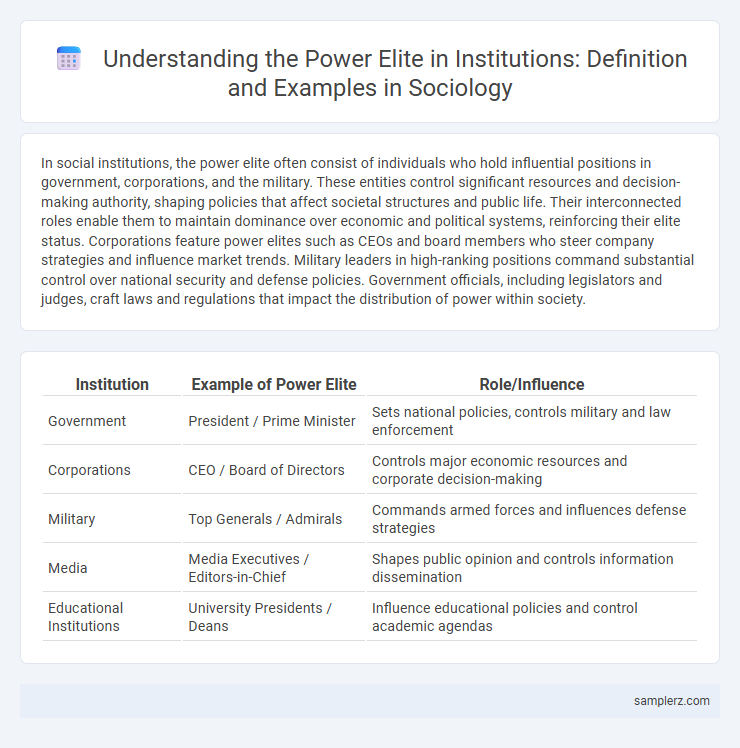In social institutions, the power elite often consist of individuals who hold influential positions in government, corporations, and the military. These entities control significant resources and decision-making authority, shaping policies that affect societal structures and public life. Their interconnected roles enable them to maintain dominance over economic and political systems, reinforcing their elite status. Corporations feature power elites such as CEOs and board members who steer company strategies and influence market trends. Military leaders in high-ranking positions command substantial control over national security and defense policies. Government officials, including legislators and judges, craft laws and regulations that impact the distribution of power within society.
Table of Comparison
| Institution | Example of Power Elite | Role/Influence |
|---|---|---|
| Government | President / Prime Minister | Sets national policies, controls military and law enforcement |
| Corporations | CEO / Board of Directors | Controls major economic resources and corporate decision-making |
| Military | Top Generals / Admirals | Commands armed forces and influences defense strategies |
| Media | Media Executives / Editors-in-Chief | Shapes public opinion and controls information dissemination |
| Educational Institutions | University Presidents / Deans | Influence educational policies and control academic agendas |
Defining Power Elite in Social Institutions
Power elite in social institutions typically consist of influential individuals occupying key positions in government, corporate leadership, and military command, shaping policies and decisions that affect entire societies. These elites control significant resources and wield authority through interconnected networks, reinforcing social hierarchies and institutional dominance. C. Wright Mills' concept of the power elite highlights how their concentrated power limits democratic participation and perpetuates social inequality.
Historical Roots of Power Elites
The historical roots of power elites trace back to institutions like monarchies, aristocracies, and colonial administrations that concentrated authority within a small, interconnected group. These elites typically controlled political, economic, and military resources, shaping societal hierarchies and decision-making processes over centuries. Examples include the British aristocracy during the Victorian era and the military-industrial complex that emerged in the United States after World War II.
Power Elite in Government Structures
The power elite in government structures often include top officials such as presidents, prime ministers, and cabinet members who control key policy decisions and national resources. These individuals typically have extensive networks linking military, corporate, and political institutions, consolidating influence across multiple domains. Their ability to shape legislation, direct intelligence agencies, and control defense spending exemplifies the centralized nature of elite power within state governance.
Corporate Leaders as Institutional Power Elites
Corporate leaders shape economic policies and influence government decisions through their control over major companies and financial institutions. Their access to extensive networks and resources enables them to dictate market trends and labor practices, reinforcing their dominant position in society. This concentration of economic power exemplifies the role of corporate executives as key institutional power elites.
Religious Institutions and Their Power Elite
Religious institutions such as the Vatican exhibit a distinct power elite, including high-ranking clergy like cardinals and the pope, who influence global religious doctrine and political decisions. This elite controls vast economic resources through church-owned enterprises, donations, and investments, shaping social and cultural norms worldwide. Their authority extends beyond spirituality, impacting education, healthcare policies, and international diplomacy.
Educational Elite in Academic Institutions
Educational elites in academic institutions consist of influential university administrators, renowned professors, and key policymakers who shape curricula and research priorities. These individuals often hold significant sway over funding allocations, academic standards, and institutional governance, reinforcing their dominance within the educational hierarchy. Their decisions impact not only institutional reputation but also access to opportunities and resources for students and faculty alike.
Military Leadership as a Power Elite
Military leadership represents a core example of a power elite within institutional structures, wielding significant influence over national security and policy decisions. High-ranking officers often possess exclusive access to strategic resources and classified information, shaping both domestic and international affairs. Their integration into government advisory roles and defense industries further consolidates their elite status and control over military and political power.
Media Moguls Shaping Societal Narratives
Media moguls such as Rupert Murdoch and Jeff Bezos exemplify power elites by controlling vast networks of news outlets and influencing public opinion on a global scale. Their ownership of major media corporations like News Corp and The Washington Post enables them to shape societal narratives, political agendas, and cultural discourse. This concentration of media power significantly impacts democratic processes and the flow of information within society.
Power Elite Networks in Healthcare Systems
Power elite networks in healthcare systems often include influential top executives, key policymakers, and leading medical professionals who collectively shape institutional decisions and resource allocation. These interconnected individuals leverage their positions to influence healthcare policies, funding priorities, and organizational governance. Understanding these power elite dynamics is crucial for analyzing disparities in access to care and the prioritization of medical innovations.
Social Mobility and the Reproduction of Power Elites
Power elites in institutions often control key economic, political, and social resources, enabling them to maintain dominance across generations through exclusive networks and cultural capital. Social mobility is constrained as these elites use education, social clubs, and legacy admissions to reproduce their status and influence. This systemic reproduction limits access for lower socioeconomic groups, reinforcing inequality and preserving established power structures.

example of power elite in institution Infographic
 samplerz.com
samplerz.com